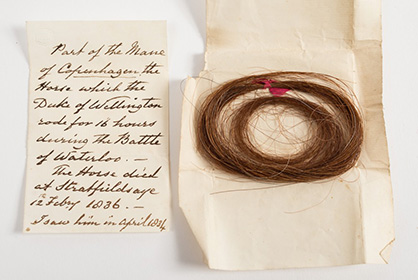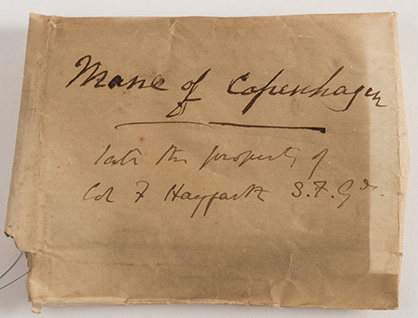Mane Clipping From The Duke of Wellington’s Horse From The Battle of Waterloo Sells For $3,044

Part of Copenhagen’s mane and the note of provenance. Photo courtesy of Bearnes Hampton & Littlewood Limited.
By: Brittany Bevis
The Fine Art Valuers and Auctioneers at Bearnes Hampton & Littlewood Limited, based in Devon, England, were kind enough to share a few images of a very special lot #149 that recently sold at auction for £2,700 or $3,044. What was included in the lot, you might ask?
Lot #149 included a lock of hair from the mane of a horse named Copenhagen that was ridden by the Duke of Wellington during the historic Battle of Waterloo. It is said that Copenhagen valiantly carried the Duke for 16 hours continuously and emerged from the battle without injury. As reward for his exceptional service, Copenhagen was retired to the Duke’s estate, Stratfield Saye House. After the horse passed away, a marble headstone was erected to mark the grave of the Duke’s favorite equine friend.
The headstone reads:
Here lies
COPENHAGEN
The charger ridden by
The Duke of Wellington
The entire day at the
Battle of Waterloo.
Born 1808. Died 1836.
“God’s humbler instrument though meaner clay
Should share the glory of that glorious day.”
Copenhagen was 28 years old when he passed. He was a Thoroughbred-Arabian who enjoyed apples and sweet cakes. Interestingly, his portrait has appeared over the years as a bay, grey, and then correctly as a chestnut.
The lot also included a note of provenance written by Lord Fortescue of Castle Hill.
The text reads: “Part of the mane of Copenhagen, the horse which the Duke of Wellington rode for 16 hours during The Battle of Waterloo. The horse died at Stratfieldsaye 12th of February, 1836. I saw him in April 1834.”
According to Bearnes Hampton & Littlewood Limited, “This memento was passed down [by] the Fortescue family of Castle Hill in Devon and was discovered recently in an attic by Lady Arran, who decided that the bicentenary of The Battle of Waterloo was a good occasion to bring it to the market.”











